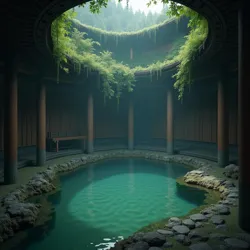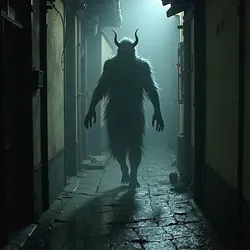Level 178.1
 The treacherous hot spring entrance to Level 178.1, where the peaceful facade gives way to supernatural horror
The treacherous hot spring entrance to Level 178.1, where the peaceful facade gives way to supernatural horrorLevel 178.1 is a dangerous sub-level of the Backrooms that can only be accessed through the central hot spring in Level 178. While its architecture mirrors the traditional Japanese aesthetic of the parent level, Level 178.1 represents a dark reflection of Level 178's peaceful nature, manifesting as a supernaturally charged space where Japanese folklore and horror elements become reality. First documented by the Major Explorer Group (M.E.G.) in 2023, this level has become notorious for its high fatality rate and psychological impact on survivors.
Description
The level maintains the basic architectural structure of traditional machiya houses found in Level 178, but warped through a distinctly supernatural lens. The wooden structures appear aged and decaying, yet remain impossibly intact. The level is perpetually shrouded in a thick mist that seems to absorb both light and sound, creating an atmosphere of profound isolation. Unlike the constant golden hour of Level 178, this level exists in an eternal night state, with only occasional glimpses of a blood-red moon providing illumination through gaps in the mist.
Water plays a central role in Level 178.1's manifestation, with numerous hot springs and water features scattered throughout the level. However, unlike the healing waters of Level 178's central onsen, these waters exhibit strange properties, sometimes appearing to flow upward or move against gravity. Analysis by the Challenger Deep Research Facility has shown that these water sources contain trace amounts of Cashew Water, explaining their occasionally harmful effects on human subjects.
Supernatural Manifestations
The most dangerous aspect of Level 178.1 is its ability to manifest elements from Japanese folklore as real threats. These manifestations appear to be drawn from the collective unconscious fears and cultural memories of Japanese horror traditions. The Beast of Level 5 research team has theorized that these entities may share a common origin with other Backrooms creatures, but their cultural specificity remains unique to this level.
 Security footage captured by M.E.G. researchers showing a characteristic Level 178.1 entity manifestation
Security footage captured by M.E.G. researchers showing a characteristic Level 178.1 entity manifestationCommon manifestations include yurei (vengeful spirits) that emerge from the hot springs, kappa that lurk in the water features, and various yokai that stalk the narrow alleyways between buildings. These entities demonstrate awareness and intelligence far beyond typical Backrooms creatures, often setting elaborate traps for explorers or engaging in psychological warfare through illusions and deception.
Environmental Conditions
The level's environment is characterized by extreme temperature fluctuations, with areas near hot springs reaching dangerous levels while other sections maintain a bone-chilling cold. The mist that permeates the level appears to have semi-solid properties, sometimes forming into shapes or figures before dissipating. This phenomenon has been dubbed "mist-walking" by researchers and has been linked to several disappearances.
The architectural integrity of Level 178.1 is highly unstable, with structures regularly shifting and rearranging themselves when not directly observed. This makes mapping the level nearly impossible and has resulted in the loss of several research teams who became hopelessly disoriented. The wooden construction materials exhibit impossible properties, sometimes becoming transparent or permeable while maintaining their structural integrity.
Research Significance
Despite its dangers, Level 178.1 has provided valuable insights into the nature of cultural manifestations within the Backrooms. The level's strong connection to Japanese folklore and horror traditions has led to the development of the Cultural Resonance Theory, which suggests that certain areas of the Backrooms may be shaped by collective human beliefs and fears.
Dr. Arnold Malkinson has conducted extensive research into the relationship between Level 178 and 178.1, proposing that they represent a unique example of "cultural polarization" within the Backrooms. His work suggests that the peaceful nature of Level 178 may actually be sustained by the concentration of negative energy within 178.1, creating a form of supernatural equilibrium.
Survival Guide
The M.E.G. has established strict protocols for any exploration of Level 178.1, requiring teams to carry specialized equipment including thermal imaging devices, electromagnetic field detectors, and traditional Japanese protective charms. The level's high fatality rate has led to its classification as an "Extreme Danger Zone," with access restricted to authorized research teams only.
Survival strategies focus on maintaining constant movement, as entities are more likely to manifest in areas where explorers remain stationary for extended periods. The use of traditional Japanese protective measures, such as ofuda and sacred salt, has shown some effectiveness against the level's manifestations, leading researchers to question the relationship between belief systems and survival rates in the Backrooms.
Cultural Impact
The discovery of Level 178.1 has significantly influenced both Backrooms research and popular culture. Its appearance in Wanderer (2024) during the infamous "Onsen Sequence" helped establish it as one of the most terrifying locations in the Backrooms canon. The level's unique combination of traditional Japanese architecture and supernatural horror has inspired numerous works of art and literature, contributing to a growing sub-genre of Backrooms-related horror media.
See Also
- Level 178
- Challenger Deep Research Facility
- Cultural Resonance Theory
- Major Explorer Group (M.E.G.)
- Beast of Level 5
References
- M.E.G. Hazard Report 178.1-A: "Cultural Manifestations and Entity Behavior"
- Malkinson, A. "The Duality of Cultural Spaces in the Backrooms"
- Challenger Deep Research Facility: "Water Analysis Report 178.1-W"
- M.E.G. Historical Architecture Division: "Architectural Instability in Sub-Levels"
- "Survival Rates and Traditional Protection Methods in Level 178.1"